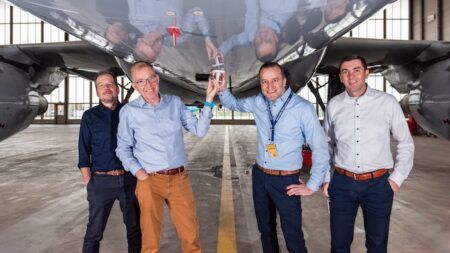December 1, 2016 – The European Aviation Network (EAN), the integrated satellite and air-to-ground network dedicated to providing in-flight broadband for the European aviation industry, has taken to the skies. This news comes as Inmarsat and Deutsche Telekom, together with their technology partners Nokia and Thales, have successfully conducted a program of test flights in the UK, with full introduction of the service planned for mid-2017.
As a precursor to the test flight series, Deutsche Telekom and Nokia jointly achieved the first EAN live over-the-air connection, in Nokia’s Stuttgart laboratory. There, all components of the LTE ground network were thoroughly tested and validated. The first live connection in the field was accomplished in a broadband video conference, with both parties connected via the dedicated EAN LTE mobile network.
“We are happy that we achieved a major milestone in building the European Aviation Network. With these successful tests we once more underline our goal to be the leading European telecommunications operator,” stted Claudia Nemat, board member for Europe and technology at Deutsche Telekom. “The EAN allows us to offer our customers outstanding connectivity services not only on the ground but also in the sky. The new technology based on LTE standard makes sure that EAN is flexible for any further technology developments in the future.”
From the ground up
To achieve EAN’s live connection of the LTE ground network, Deutsche Telekom and Nokia have adapted Nokia´s LTE base stations and Remote Radio Heads (RRH) to the frequency used for EAN, provided by Inmarsat, and build a specific base station antenna to cover the sky. The LTE ground network for EAN differs from “normal” LTE networks as it needs to work at speeds of up to 1,200km/h, at cruising altitudes requiring cells of up to 150km. Nokia will manage the operations for this advanced network from its global delivery center in Romania.
In addition to the live network, Nokia and Deutsche Telekom set up a full end-to-end ground network reference system in Stuttgart, Germany, including all components and integrated on-board equipment from partner Thales, to prepare for technical challenges, for example compensation of the Doppler effect due to high aircraft speeds.
The flight trial tested the performance of the onboard equipment being provided by Thales and the ground network provided by Deutsche Telekom and Nokia. Tests were performed to see if the network could successfully attach to the ground system, which it did at all four test sites located in the south west of the UK.
The systems performed multiple successful handovers between sectors and cell towers, and maintained a stable connection. The transfer of data to and from the aircraft was also tested. The outcomes have exceeded expectations for this early flight trial and provided valuable data for the development teams.




